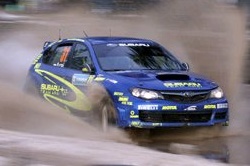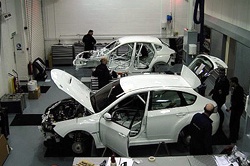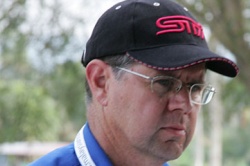 Understandably, there’s been a lot attention given to new drivers and new teams entering the APRC this year. But there’s also plenty of change happening inside the team that dominated series last year.
Understandably, there’s been a lot attention given to new drivers and new teams entering the APRC this year. But there’s also plenty of change happening inside the team that dominated series last year.
MotorImage will embark on their 2008 campaign with the same driver line-up and key personnel, but there’s a new addition to the team. The all-new 2008 Subaru WRX STI.
The previous generation of Subaru group-N rally car was introduced in 2002. Not only does the new car look different, there are major changes under the bodywork.
So to find out more, I sat down with MotorImage team manager Philip Rodgers and Kevin Sanderson, the head of Possum Bourne Motorsport and the man responsible for turning a WRX STI into a championship winning rally car.
BM: Kevin, obviously a completely new generation of group N rally cars don’t come along very often. Can you briefly describe the process of taking these base cars and turning them into a rally car, and what can you take straight across from the old WRX?
KS: I guess there’s always something we can take across; our knowledge and technology. The way we do certain things. Fuel lines, break lines, the way we do front suspension is very similar. Rear suspension is the biggest change in the car.
The body shape is obviously different, but the underneath of the car is traditionally Subaru with a boxer engine, north-south airbox and a diff in the back, which is traditional for us. The rear suspension is the key to this car, and to get our speed I think.
 BM: In terms of the engine, it’s similar to the old car?
BM: In terms of the engine, it’s similar to the old car?
KS: For all intents and purposes, it is the same engine. It has (new) cam controls for exhausts. We’ve been managing the inlet cam for two or three years now, and we don’t think (that) managing the exhaust cam is going to be any issue at all. From what we understand the output is going to be something similar, maybe a little better.
BM: I think the specs for the new car say it’s around 40kg heavier than the old car (in base specification)?
KS: I hope that’s not the case, but unfortunately it sounds like it is. The car is going to be heavier, but we’re just going to have to work hard to make sure we minimise the weight we put into it. It’s going to end up heavier. (By) how much is yet to be determined, until we finish the car.
The cars, traditionally, have places that we end up strengthening. This car looks a lot stronger, so there’s a little bit less welding. Every time we put a welder on it we add weight. So, yes, there’ll be some weight we have to live with, but we possibly won’t add as much to it as we have traditionally. Time will tell, but if we can limit it to 14-20kgs, we’ll be pretty happy.
BM: Working within the FIA regulations, do you have much opportunity to move the weight around in the car, balancing it up from front to rear?
KS: We do everything we can to shift the weight to the rear, where possible. If you can mount something in the car, the jack for instance, if mounting in in the rear, keeping it low, keeping rear-ward, all those things are beneficial.
If you got to put weight in, you may as well put it where it’s most beneficial. It’s a logical choice. You don’t want to hide your jack so the co-driver can’t get it, even though the weight distribution is better.
BM: You’ve got the car coming in for the New Zealand round. How much testing are you going to have before that.
KS: I’d like to think we’d get a weeks testing. We’ll probably do it in two lots. We’ll probably do five days, and then, maybe, just before Canberra we’ll have another lash at it. We might do that in Canberra.
Testing is one of those things….when you first shake it down, the results determine how much more you need to go. We’ll back-to-back it with one of our current cars, and if we can get it to go as quick as our current cars in the first test, we’d be pretty satisfied with that.
Looking at the car, it looks like it will potentially handle better off the rear. Potentially.
 BM: Philip, looking at the championship this year, you’ve got MRF looking to bounce back with Scott Pedder, Dean Herridge in the Cusco car, potentially new teams coming out of Japan. Are you going to introduce the new car as soon as it’s available, or is it a matter of looking at the points after the first couple of rounds to determine the best time?
BM: Philip, looking at the championship this year, you’ve got MRF looking to bounce back with Scott Pedder, Dean Herridge in the Cusco car, potentially new teams coming out of Japan. Are you going to introduce the new car as soon as it’s available, or is it a matter of looking at the points after the first couple of rounds to determine the best time?
PR: Ahh…no. We’re introducing the new car in New Zealand, subject to nothing popping up that might delay it. But that’s the plan at the moment. It’s going to be a pretty exiciting championship I think with Scott Pedder, and the MRF team are strong enough anyway. We’ve got two years of championships to defend; it’s not going to be easy.
BM: So New Zealand, come hell or high water, so long as its ready?
PR: We don’t expect any issues. We’re developing this car a little bit behind the people who are doing PWRC, so that’s an advantage for us. We don’t expect any problems; the car’s a strong car. We already know that. All the indications are that it’s a superior handling car. The engine’s a little bit stronger. It’s going to be a good car. We’ve got a little bit to do, to get our heads around the rear-end, but it will be a good thing.
BM: Is there a lot of information sharing between the six companies who are providing the base car (worldwide)?
PR: Oh yes. And that’s all co-ordinated by STi in Japan and George Donaldson, based in Europe. We work very closely with STi in Japan…we first saw this car six months ago. We’ve been working on it for some time.
Photos courtesy of Subaru MSM.
